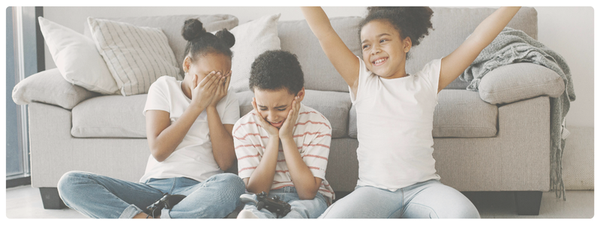Summer can feel like a season of endless possibility. It can also be filled with too many moments of, “I’m bored!” When used with intention, screen time activities can be a great way to support kids in the summer, to help them curb their summer boredom, build skills, and relax.
With school and extracurriculars on pause, families often face long stretches of unstructured time, where screens naturally become the go-to. And while screens are a normal part of 21st-century life, they can start to feel like the default in summertime. That’s when the guilt creeps in.
- Are my kids spending too much time on their devices in the summer?
- Are they spending too much time inside?
- Shouldn’t they be bored sometimes?
Summer is an extended season of natural learning. That’s the kind of growth and development that happens through self-guided play, curiosity, and everyday experiences. Screen time can help empower and balance these, with summertime rules that blend flexibility, downtime, and active engagement.
I like to approach summer screen time rules less with a rigid or limiting approach, and more of a flexible, family-specific rhythm. For me, a three-part daily rhythm has helped to structure wide-open summer days without over-scheduling or over-policing. It’s not about strict limits, but about giving kids predictable blocks of time to move, play, rest, and yes, enjoy screens intentionally.
With this approach, we create a gentle structure, reduce screen-time stress, and make space for play, rest, and connection.
Green, Screen, Serene: A 3-Part Rhythm for Summer Screen Time
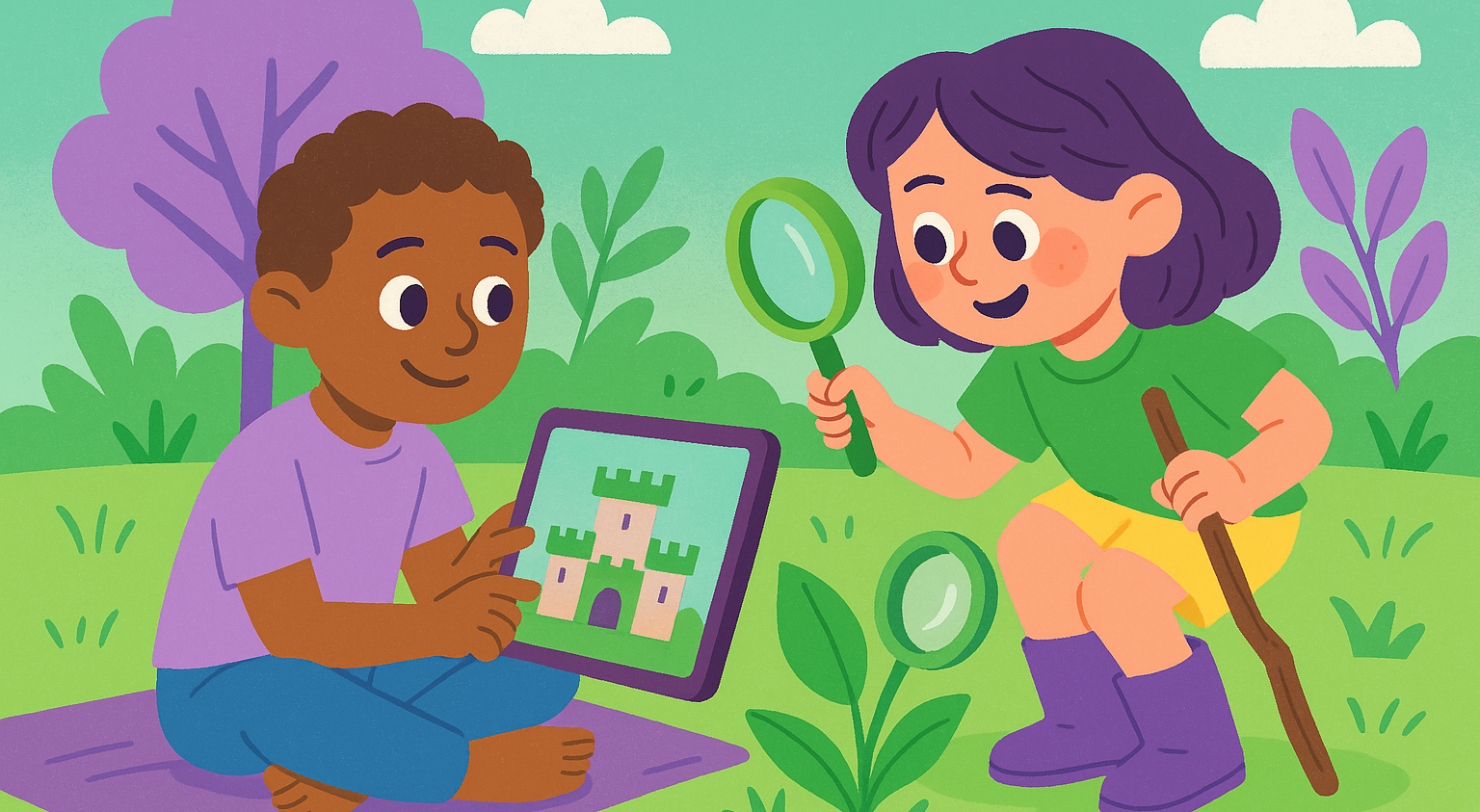
Rather than strict screen-time rules, consider this rhythmic approach: three simple blocks of the day that give kids a predictable flow while still allowing plenty of flexibility.
Think of it as scaffolding to summertime days. It doesn’t lock you in, but it gives structure to the day in a way kids can follow (and even help shape). Each block in this rhythm — Green, Screen, and Serene — supports a different kind of learning, growth, and rest.
These blocks can be 20 minutes or two hours depending on your day. They can be repeated, stacked, and moved in whatever ways fit your family’s schedule and digital wellness goals. It is not about trying to set a rigid schedule, but rather bringing variety to the day and helping kids move between play, screens, and downtime easier, smoother, and with less negotiation.
OK, Green-Screen-Serene — here’s how your summer screen time rules can flow.
Green time
Green is all about unstructured outdoor time: movement, creativity, and sensory play in nature. The idea of a Green Hour comes from the National Wildlife Federation, which originally coined the term to encourage kids to spend at least an hour each day outdoors. Not sure where to start? What if we let our child’s screen interests inspire what they do outside? Hear me out.
Do your children love Minecraft? Why not use that to inspire a build challenge, seeing what they can mash together with natural “Minecraft” materials like stone and grass. Does your child love Wild Kratts, or other nature-based shows, as much as mine do? Let that inspire a bug hunt or a backyard safari.
Perhaps they are still very much in their “wizard” era? Help them set up a “wand making station” in the backyard with remnants of your crafting supplies and have them go off to find the perfect stick to start with.
When outdoor play is connected to something they already love, kids are more likely to dive in and discover something new along the way.
Outdoor play is a full-body learning experience. It supports mental health, creativity, and problem-solving. And it’s a rare chance for kids to use all five senses at once. That kind of sensory variety helps them grow emotionally and cognitively.
Time outdoors, in nature also supports independence. Even just being in the backyard on their own (with age-appropriate supervision) gives kids a sense of autonomy. Your presence is like scaffolding. They know you’re nearby, but they get to make their own choices. And that fosters real growth.
Screen time
Blocks of screen time give your kids dedicated time to watch, play, and explore intentionally with screens. That doesn’t mean every show has to be educational or every game co-played. Intentional screen time is time that’s chosen, purposeful, and bounded. It’s not endless scrolling.
This might look like:
- Watching an episode of a favorite show over lunch together
- Exploring a topic sparked by outdoor play (like frogs, space, or castles) through digital media
- Playing a video game that involves building, storytelling, or music
While active screen time can be a better option to keep gears turning, build life skills, and get the most from screen sessions, it doesn’t have to all be so growth-oriented. Keeping a balanced digital diet means allowing for some screen treats, such as a favorite show or movie, regardless of the entertainment-to-education value ratio.
Entertainment matters. We all need downtime. Even passive content can be emotionally meaningful or spark ideas. The key is that it’s part of a balanced day, not the whole day.
If you want to use this as a time for extra connection with your kids, that’s still possible. Watch alongside your child for a few minutes, ask what they like about it, or let them retell the story afterward. Co-engagement doesn’t have to take long—it just needs to be curious and genuine.
Serene time
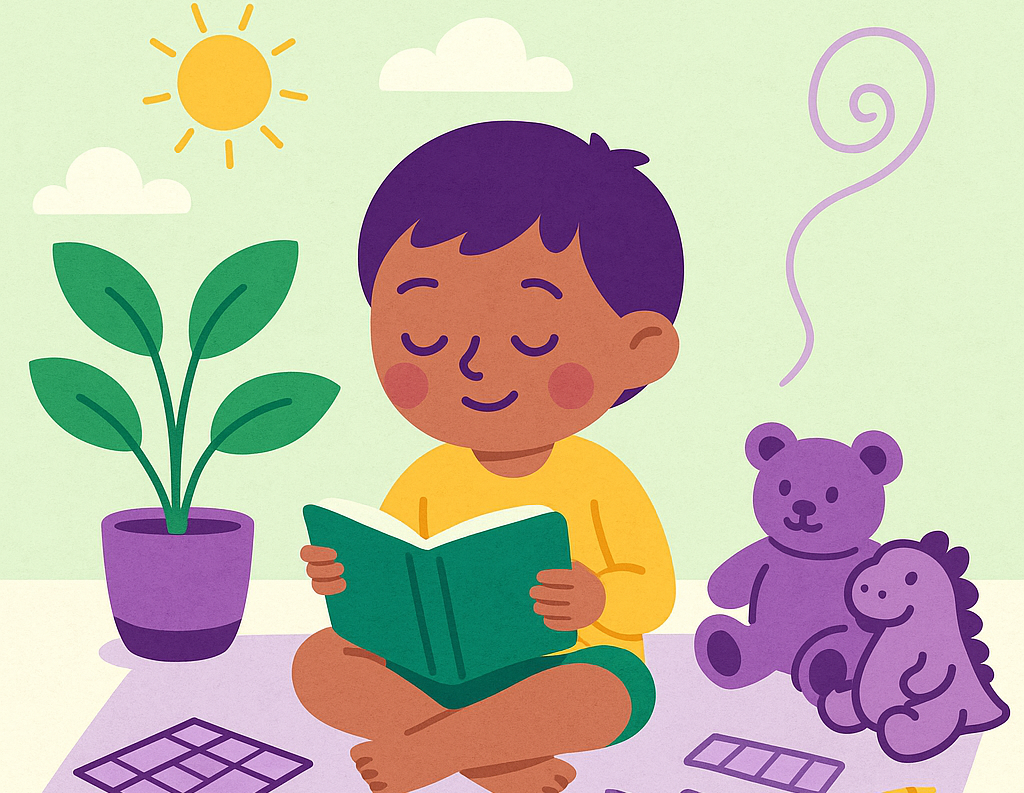
This is some quiet time — although serene makes for a much catchier rhyme to our rhythm. A block of serenity can bridge all the activity and entertainment to bring a moment of focused calm to a summer day. It’s time for independent, low-stimulation play: puzzles, drawing, reading, building, or simply lying on the floor daydreaming.
This is the perfect time to lay in the grass and find shapes in the clouds. Or to engage in some independent play that builds self-regulation, patience, focus, and autonomy. Time like this helps kids learn how to manage their own attention and emotions, which are skills they’ll need for the rest of their life.
What if this kind of play doesn’t come naturally to your kids? Going from the constant engagement of the school day to the relatively slower pace of the summertime can make it especially challenging. Getting used to the quiet, calm, focused Serene block might take some time.
Start by setting up the space: a small basket of books, two open-ended toys, maybe a coloring pad and markers. Let them choose, and stay nearby at first if needed. Over time, you can step back and let them take the lead.
And remember: serene doesn’t always mean silent. Some kids hum, narrate, or play noisily even when they’re deeply focused. Calm play looks different for every kid. For some, it’s making dinosaur sounds alone in the corner. For others, it’s building quietly for 30 minutes. There’s no one right way, as long as it gives them space to reset.
If your child says they’re bored? That’s okay. Boredom isn’t a problem, it’s an opening. A chance to imagine, explore, and try something new. In fact, boredom is often where creativity begins.
Research Backs the Rhythm
One of the most common concerns I hear from parents in the summer is that screens start to feel like the default. Without school or regular routines, the days stretch long, and screens become the go-to solution for boredom, quiet, or a quick break. Then many parents start to feel unsure, guilty, or disconnected from their kids’ screen use.
You don’t have to eliminate screens, just build the rhythm and structure kids need to default to them less often or to make more intentional choices when they do. A sense of flow, predictability, and choice throughout the day goes a long way.
Kids thrive on structure. When they know what’s coming next, whether it’s time to play outside, time to watch a show, or time to play quietly on their own, it reduces anxiety and helps them settle into the day. Rhythms like Green, Screen, and Serene give them that consistency without being overly rigid. You’re not planning every minute, you’re giving the day a shape. You’re filling in “default” moments.
This kind of structure can also reduce power struggles. When there are no clear boundaries, it’s easier for kids to push back or constantly ask for “just one more show.” But when the rhythm becomes the expectation, it’s easier to stick to it. It becomes part of the day’s natural flow.
Routines that blend movement, downtime, and intentional screen use support emotional regulation, attention, and learning by providing a structure while keeping the “novelty” value high. A variety of experiences throughout the day — active, passive, social, independent — helps build a range of skills, from creativity to focus to resilience.
Most importantly, a rhythm like this supports caregivers, too. It gives you breathing room. Instead of constantly reacting, you’re guiding. That small shift makes a big difference.
Tips to Reduce Resistance
Even with a rhythm in place, transitions can be tough, especially in summer. Kids know it’s a break from school. They associate it with freedom, flexibility, and doing what they want. That’s totally valid, but also why rhythm and structure are so helpful.
Summer feels like vacation to kids, which they think means doing whatever they want. Rhythm helps give the day shape, without turning it into school at home.
Here are a few ways to make that rhythm easier to follow (and easier for caregivers to manage, too):
Let screens spark outdoor play
Screens don’t have to be the opposite of play, they can be a bridge to it. If your child built a castle in a game, challenge them to build one with sticks or blocks outside. If they’re watching animal videos, go on a backyard safari.
It’s not screen time versus outdoor time, it’s all play — we’re just using what they’re interested in to expand where and how they play.
This approach works because kids are creatures of persuasion. If you suggest something grounded in what they already enjoy, they’re much more likely to go along with it and stay engaged once they’re out there.
Use visual schedules
Visual schedules help kids anticipate what’s coming next and feel more in control of their day. It can be as simple as drawing boxes on paper together or using magnets on the fridge for Green, Screen, and Serene blocks.
Make it collaborative. Let them help create the schedule. That way, it’s not something being imposed, it’s something they helped shape.
Even just posting a block of time (like ‘quiet time: 1–2:30’) and sticking it on the fridge gives kids a reference. If they ask to watch a show at 1:15, you can point to the schedule instead of having the same conversation again.
Feel free to borrow visual language from games. You could draw a screen-time “health meter,” use icons or emojis, or show blocks filling in like a progress bar. Playful visuals help kids connect the rhythm to something familiar.
Soften transitions
Most screen-time battles aren’t about screens, they’re about abrupt transitions. Kids have trouble shifting gears, especially if they don’t see it coming.
Kids are really bad at judging time, I remind families. Timers, visual cues, even just a five-minute warning help reduce that friction. Get the complete Screen Time Guide for Parents for more on screen time transitions.
Try setting a kitchen timer or phone alarm to signal the end of Screen Hour, or use a sand timer they can watch. The goal is to make transitions expected, not surprising.
Co-watch or check in
Even if you’re busy (or working from home), short moments of co-engagement go a long way. Sit beside them for a few minutes. Ask what they’re playing. Let them tell you about their favorite character or level.
You don’t have to co-engage for the entire time, especially as they get older. But even just checking in shows you’re interested, and it helps you stay aware of what they’re watching or playing to make sure it’s age-appropriate and in line with your family’s values.
Be flexible
Some days will be screen-heavy. Maybe it’s raining. Maybe you’re sick. Maybe they’re just exhausted and all they really want is one more episode of their favorite show. That’s okay.
If it’s a high-screen day, think about adding more curation or connection. Play something together, pick a collaborative game, or co-watch a movie you can talk about after. Sometimes, loafing around can be cool, too, or other days might be spent 100% outdoors, or maybe they end up drawing pictures inside all day. The structure is there when they need it, but doesn’t work against them if they’ve found a good mix for the day.
Remember, the goal is balance over time, not perfection every day. Guilt doesn’t help you or your kids. A rhythm like Green, Screen, Serene gives you touchpoints to return to without pressure.
Summer Structure without the Stress
The key to summer screentime rules that work is this rhythm. Avoiding rigid rules in place of flexibility and balance creates a smoother summer, when kids get to move, play, rest, and explore in ways that support their development and your schedule.
When you use a simple structure like the Green-Screen-Serene rhythm of time blocks, you’re giving your kids a full spectrum of experiences: physical movement, imaginative play, digital curiosity, boredom, focus, and emotional reset. It’s a rhythm that supports how kids learn and grow while giving you some breathing room.
You don’t have to feel guilty about screen time in the summer. Screens are a normal part of life, just one of the tools in a digital parent’s kit. And when they’re balanced with other experiences, they can absolutely support creativity, learning, connection, and relaxation.
What matters most is that you’re being intentional, not perfect. A flexible rhythm like this helps take the pressure off. You don’t have to default to screens or fight against them. You can make space for both.
Some days will go sideways. Some days the rhythm will click beautifully. Either way, you’re still doing the work of helping your child feel safe, stimulated, and supported. That’s what matters. Keep coming back to the rhythm as a tool that makes summer feel a little more manageable for everyone.


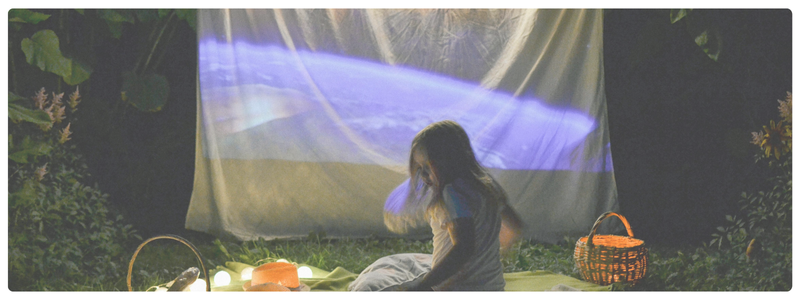

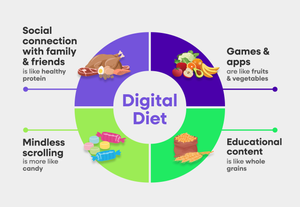
 Copy Link
Copy Link
 Share
to X
Share
to X
 Share
to Facebook
Share
to Facebook
 Share
to LinkedIn
Share
to LinkedIn
 Share
on Email
Share
on Email



